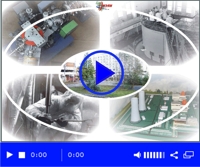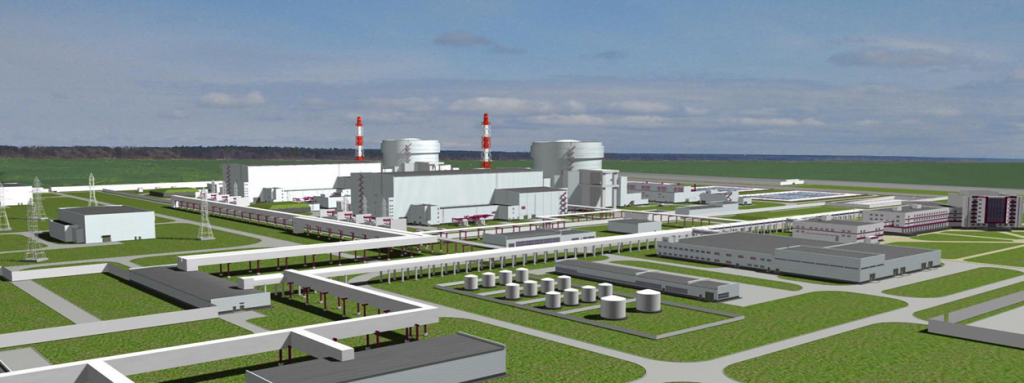Belarusian nuclear power plant project
The Belarusian nuclear power plant project is a project to construct a nuclear power plant in Belarus.
The project foresees construction of two nuclear reactors between 2016 and 2020, and probably two more reactors by 2025. The reactors would be supplied by Atomstroyexport and the plant would be located in the Astravets district, Hrodna region.
In the 1980s there were plans to build a nuclear heating and power plant in Rudensk, some 50 Kilometers south of the vicinity of Minsk. Following the Chernobyl nuclear disaster, these plans were halted. The plant was to comprise two VVER-1000 nuclear reactors, designed to provide both electricity and heat for the city of Minsk. The reactors would each have had a power rating of 900 MW net and 940 MW gross capacity. The plans for both reactors were cancelled.
Virtual tour of the nuclear power plant
The nuclear initiative was revitalized after Belarus gained independence from the Soviet Union. On 22 December 1992, Belarus announced its intention to build nuclear power plants and started a program to examine 15 possible sites. It was foreseen that the first unit of 500-600 MW would be commissioned by 2005, and additional units with a combined capacity of 1,000 MW by 2005 and 2010. However, no decision concerning site or reactor type was made. In 1999, the Government of Belarus adopted nuclear moratorium.
On 2 May 2002, Belarusian President Alexander Lukashenko stated that Belarus would not construct a nuclear power plant on its territory, but was interested in purchasing nuclear power from Russia, and in the possibility of constructing a Belarus-owned reactor at the Smolensk nuclear power plant in Russia. However, in mid 2006, the Government of Belarus approved a plan for the construction of an initial 2000 MWe nuclear power plant in the Mahilyow Voblast using pressurized water reactors technology.
After the Russia-Belarus energy dispute in 2007, Lukashenko re-declared that to ensure national energy security, Belarus needed to build its own nuclear power plant. The Belarusian Security Council made the decision to construct a nuclear power plant on 15 January 2008. According to the presidential decree signed in January 2008, the first reactor of the nuclear power plant should be operational by 2016, and the second one by 2018. The Nuclear Power Act, covering the design and construction of nuclear facilities, the security, safety, and physical protection of such facilities, and their regulation (and also prohibiting the production of nuclear weapons and other nuclear explosives), was adopted by the House of Representatives of the National Assembly of Belarus on 25 June 2008.
In June 2007, Russia offered a US$2 billion credit line for the purchasing of equipment from Russia’s Power Machines Company. In January 2009, it was decided that the nuclear power plant will be built by Atomstroyexpoert and the Russian loan was agreed in February 2009.
On 27 February 2008, Iran announced that it is ready to provide assistance to Belarus in the construction and operation of a nuclear power plant in areas such as funding, personnel training, the sharing of experience, the installation of equipment, and training in operating such equipment.
On 1 July 2009, a Ukrainian NGO sent a complaint to the Implementation Committee of the Espoo Convention alleging numerous violations of the Espoo Convention. In particular, the complaint argues that Belarus is in violation of the requirements of the Convention by pre-defining two key alternatives of the nuclear power plant construction – location and no-action alternative, as well as by not establishing an environmental impact assessment procedure that permits public participation. In December 2009 European ECO Forum Legal Focal Points submitted a complaint to the Compliance Committee of the Aarhus Convention challenging legality of NPP construction due to violation of public participation rights provided by the Aarhus Convention.
On 22 January 2011 the news was released that the contract for the Belarusian NPP will be signed in the first quarter of 2011 with Rosatom.
Location
The location of the construction site was defined in early 2009. The nuclear power plant will be built at the Astravets (Ostrovets) site in Hrodna Voblast, 45 kilometres from Vilnius, Lithuania. Alternative sites were Chyrvonaya Palyana near Bykhaw in Mahilyow Voblast, and Kukshynava between Horki and Shkloŭ in Mahilyow Voblast.

Technical features
Russian Atomstroyexport will act as the contractor to build the nuclear power plant. Atomstroyexport would also supply the III generation VVER-1200 type reactors (“AES-2006” project). The first reactor of the nuclear power plant is expected to be operational by 2016-17, and the second one by 2018-2020. The first two reactors will have the combined capacity of around 2400 MW. It is possible that two additional reactors will be built by 2025.
The nuclear power plant is expected to cost up to US$10 billion. In addition, there are investments to upgrade the national power grid for power transmission from the nuclear power plant, and the construction of an urban settlement for the power plant’s workers.
Organization
On 12 November 2007, a decree defining the organizations responsible for preparing the construction of the nuclear power plant was signed. In accordance with the decree, a Directorate for the Construction of a Nuclear Power Plant was established under the Ministry of Energy. This directorate oversees the preparation, design and exploration works. The Nuclear and Radiation Safety Department, part of the Emergencies Ministry, is acting as the state nuclear regulator and licensing authority.
Scientific support for the project is provided by the Joint Institute for Power & Nuclear Research – Sosny of the National Academy of Sciences of Belarus.








